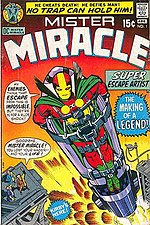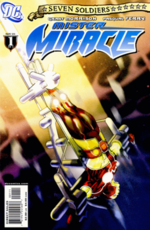Mister Miracle
This article needs additional citations for verification. (January 2009) |
| Mister Miracle | |
|---|---|
| File:Mister Miracle 22.png Cover to Mister Miracle #22 Art by Marshall Rogers. | |
| Publication information | |
| Publisher | DC Comics |
| First appearance | Mister Miracle # 1 (April 1971) |
| Created by | Jack Kirby (writer & artist) |
| In-story information | |
| Alter ego | Scott Free |
| Species | New Gods |
| Place of origin | New Genesis |
| Team affiliations | Justice League |
| Abilities | Immortality. Superhuman Strength, agility, Stamina, Coordination, Immunity and Reflexes. As the god of Escaping he is the master of Escapology bar none, aided by magic-level technology,Expert martial artist, New God inventive. Knowledge of the Anti-life Equation (and possesses the will power not to use it). He possesses the Alpha Effect. |
Mister Miracle (Scott Free) is a fictional superhero published by DC Comics. He first appeared in Mister Miracle #1 (April 1971) and was created by Jack Kirby.
Publication history
The original title featuring this character was the longest-lasting of the short-lived Fourth World tetralogy, lasting 18 issues while the other titles (New Gods and The Forever People) were cancelled after only 11 issues. The most traditionally super-heroesque comic of the various Fourth World titles, the last seven issues (as well as later incarnations of the series) would downplay the Fourth World mythology that drove the other titles in favor of more traditional super-hero fare. The title was briefly revived in the late 1970s for an additional seven issues written by Steve Englehart and Steve Gerber, before abruptly ending with #25 with several storylines unresolved.
When the character was revived as part of Keith Giffen's Justice League line-up in 1987, a one-shot special was published with art by Steve Rude in 1988.
This special was followed by an ongoing series which began in 1989, written by then-current Justice League scripter J.M. DeMatteis, and drawn by British artist Ian Gibson. Other co-writers/writers who contributed to the title include Keith Giffen, Len Wein, and Doug Moench.
This run lasted 28 issues before cancellation in 1991. The series was largely humor-driven, per Keith Giffen's reimagining Scott Free, his wife Big Barda, and their friend Oberon (who pretended to be Scott's uncle) as living in suburbia when they were not fighting evil with the Justice League.
In 1996, a series written by Kevin Dooley showed Scott attempting to escape his destiny as a New God by setting up a charitable foundation in New York. This only ran for seven issues, before all Fourth World titles were canceled for the launch of Jack Kirby's Fourth World.
With the launching of Grant Morrison's meta-series "Seven Soldiers of Victory", Mr. Miracle was revived as a four-issue mini-series. However, this mini-series focused instead on Scott's sidekick and apprentice Shiloh Norman, who Morrison has established as the new Mr. Miracle.
In addition, Scott's ally (and wife) Big Barda was made a member of the revived Justice League and appeared regularly in the Jack Kirby's Fourth World series by John Byrne, as well as several issues of "The Brave and the Bold", where Mr. Miracle teamed up with Batman.
Fictional character biography
Mister Miracle was one of four series in Kirby's ambitious but short-lived Fourth World saga. The character was inspired by the early illusionist career of comic book artist Jim Steranko, while the character's relationship with Big Barda is based on Kirby's relationship with his own wife.[1]
Thaddeus Brown
Thaddeus Brown was a circus escape artist whose stage name was Mister Miracle. As the first escape artist to use the name Mister Miracle, Brown mentored both Scott Free and Shilo Norman. After Brown's murder, Scott Free took up the Mister Miracle name, adopted Thaddeus' young ward Shilo Norman, and hired his assistant Oberon.
Scott Free

Scott Free is the son of Izaya (Highfather), the ruler of New Genesis, and his wife named Avia. However, as part of a diplomatic move to stop a destructive war against the planet Apokolips, Highfather agreed to an exchange of heirs with the galactic tyrant Darkseid; the exchange of heirs guaranteed that neither side would attack the other. Scott traded places with Darkseid's second born son Orion.
Scott grew up in one of Granny Goodness' "Terror Orphanages" with no knowledge of his own heritage. As he matured, Scott rebelled against the totalitarian ideology of Apokolips. Hating himself for being unable to fit in, he was influenced by Metron to see a future beyond Darkseid. Scott became part of a small band of pupils who were tutored in secret by the rebel Himon, a New Genesian living as a "Hunger Dog" on Apokolips. It was at these meetings that he met fellow pupil Big Barda, who would later become his wife.
Eventually, Scott Free escaped and fled to Earth. His escape, long anticipated and planned for by Darkseid, nullified the pact between Darkseid and Highfather and gave Darkseid the excuse he needed to revive the war with New Genesis. Once on Earth, he became the protégé of a circus escape artist, Thaddeus Brown, whose stage name was Mister Miracle. Brown was impressed with Scott's skills (especially as supplemented with various advanced devices he had taken from his previous home). Scott also befriended Brown's assistant, a dwarf named Oberon. When Thaddeus Brown was murdered, Scott Free assumed the identity of Mister Miracle. Barda later followed Scott to Earth, and the two used their powers, equipment, and skills in the war against Darkseid, who was still interested in recapturing both of them. Eventually, tired of being chased on Earth by Darkseid's servants, Scott returned to Apokolips and won his freedom by legal means, through trial by combat.
Scott Free later became a member of the Keith Giffen-era JLA (as did Barda and Oberon), which recast him and Big Barda as semi-retired super-heroes that sought to live quiet lives in the suburbs when they were not involved in Justice League-related adventures. In particular, Scott Free was recast as a hen-pecked husband, who often found himself on the receiving end of his wife's temper, over her desire to live a quiet life on Earth.
During his time in the League, Scott developed an intense rivalry with League villain Manga Khan. The villainous intergalactic trader and black marketer repeatedly kidnapped Scott, ultimately convincing Scott's conniving former manager Funky Flashman into forging documents forcing Scott to work for Manga as his personal entertainer. To force him to go along willingly, Khan replaced Scott with a life-like robot who was ultimately murdered by Despero during his first mission with the Justice League. Scott ultimately escaped from Manga Khan's clutches and reunited with his wife and friends, though the shock was enough to cause Scott to ultimately quit the League and to take on a protege in the form of Shiloh Norman.
Ultimately Mr. Miracle was killed off in the Death of the New Gods mini-series by Jim Starlin. During the storyline (which began with the death of Big Barda), it was revealed that Scott could harness the power of the Anti-Life Equation, which he ultimately manifested in his attempt to avenge his wife. However, when he discovered that the cosmic "Source" that is worshipped by the New Gods was responsible for the extermination of all of the New Gods, Mr. Miracle lost his will to live and allowed the Source to kill him and reclaim the Anti-Life Equation power from him.
In the conclusion of Final Crisis, the New Gods are all seemingly reborn. Among their numbers are the apparently resurrected Mister Miracle, along with Barda.
Shilo Norman

Art by Pasqual Ferry
Young Shilo Norman was the informal ward of escapologist Thaddeus Brown (Mister Miracle I), and he also served as an occasional stand-in. When Brown was murdered by a mobster named Steel Hand, Scott avenged his new friend's death by taking on the identity of Mister Miracle and brought Steel Hand to justice. After Brown's death, Shilo worked with Scott Free (the new Mister Miracle) and Scott's wife Barda.
A master escape artist himself, the now-adult Shilo was appointed security chief of the Slabside Island Maximum Security prison for Metahumans also known as the Slab. He held his own during the Joker's "Last Laugh" riot and was promoted to Warden of the Slab, which had by then been relocated to Antarctica. A somewhat reconceived Shilo Norman appears in Grant Morrison's Seven Soldiers crossover. In Final Crisis #2, Shilo approaches Sonny Sumo and tells him "There was a cosmic war and the powers of evil won", prompting him to form a team to fight the evil gods.
Other versions
- A future version of Mister Miracle and Big Barda (along with their daughter), appeared in the mini-series Kingdom Come. Being an escape artist, Mister Miracle would assist Superman in creating the Gulag, an inescapable prison for meta-humans. He and Barda have a daughter, Avia, who also uses a mega-rod and wears an outfit that combines elements of those of her parents. In the Elliot S! Maggin novelization, Free is teaching the lowlies art and constantly berates Orion to inspire (unsuccessfully) individual thought (though Scott likes Orion). Scott saves his wife and Avia near the conclusion by activating a boom tube just as the nuclear weapon explodes (Avia: "How did you know?" Barda: "He always knows").
- Mister Miracle also appeared in the Elseworlds Superman: The Dark Side, in which he becomes Metron's successor and Justice League: Another Nail, in which he achieves the ultimate escape by downloading his consciousness into Barda's mother box, just before he is tortured to death by Darkseid. The Mother Box circuitry is later bonded with a Green Lantern ring, allowing Miracle to project his consciousness into an energy construct, similar to his original body.
Other media
- Mister Miracle's first television appearance was in the animated Superman: The Animated Series episode, Apokolips...Now! Part II.
- A picture of him appears in the two parted Batman Beyond episode "The Call," where he's shown on a computer screen in the Justice League Watchtower.
- He also appeared as a background character at the end of the Justice League episode Twilight.
- Mister Miracle made a return in the Justice League Unlimited episode The Ties That Bind (which, fittingly enough, was scripted from a story outline provided by Jim Steranko) voiced by Ioan Gruffudd while his younger self was voiced by Zack Shada.
Awards
The Mister Miracle series (plus Forever People, New Gods, and Superman's Pal Jimmy Olsen) earned Jack Kirby the 1971 Shazam Award for Special Achievement by an Individual in the comic industry.
Footnotes
- Template:Fnb Mark Evanier (screenwriter, Jack Kirby biographer, and Kirby's assistant during the Fourth World comics):
- Jack based some of his characters (not all) on people in his life or in the news.... Big Barda's roots are not in doubt. The visual came about shortly after songstress Lainie Kazan posed for Playboy...and the characterization between Scott 'Mr. Miracle' Free and Barda was based largely — though with tongue-in-cheek — on the interplay betwixt Jack and his wife Roz. Of course, the whole 'escape artist' theme was inspired by an earlier career of writer-artist Jim Steranko.[1]
